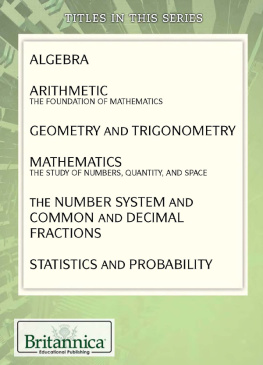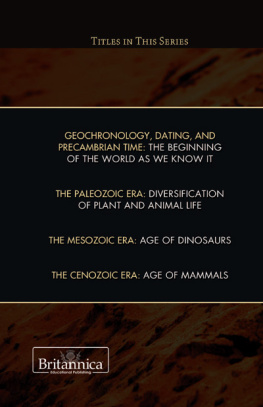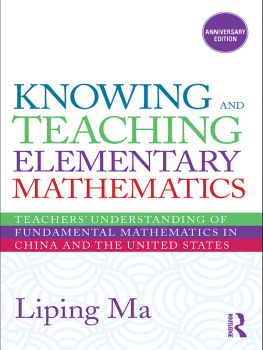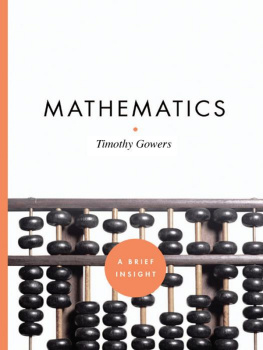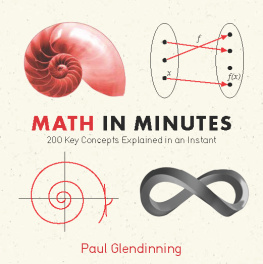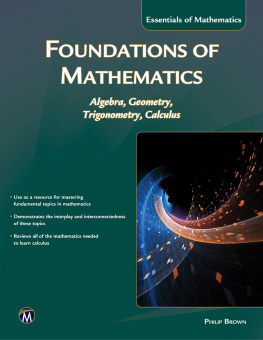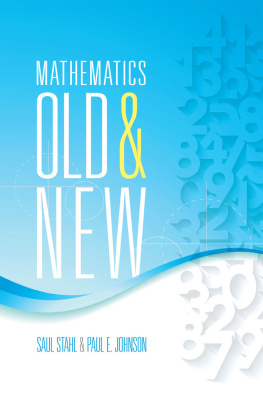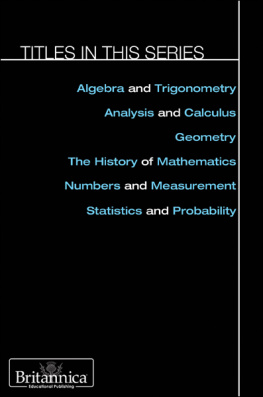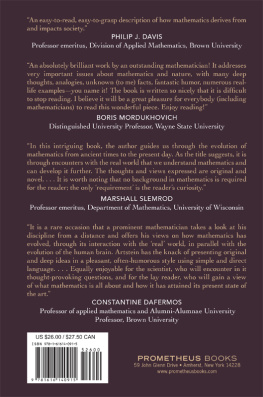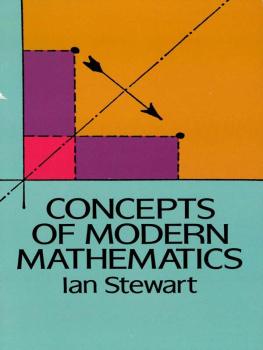MATHEMATICS
THE STUDY OF NUMBERS, QUANTITY, AND SPACE

Published in 2015 by Britannica Educational Publishing (a trademark of Encyclopdia Britannica, Inc.) in association with The Rosen Publishing Group, Inc.
29 East 21st Street, New York, NY 10010
Copyright 2015 by Encyclopdia Britannica, Inc. Britannica, Encyclopdia Britannica, and the Thistle logo are registered trademarks of Encyclopdia Britannica, Inc. All rights reserved.
Rosen Publishing materials copyright 2015 The Rosen Publishing Group, Inc. All rights reserved.
Distributed exclusively by Rosen Publishing.
To see additional Britannica Educational Publishing titles, go to rosenpublishing.com.
First Edition
Britannica Educational Publishing
J. E. Luebering: Director, Core Reference Group
Anthony L. Green: Editor, Comptons by Britannica
Rosen Publishing
Hope Lourie Killcoyne: Executive Editor
Tracey Baptiste: Editor
Nelson S: Art Director
Michael Moy: Designer
Cindy Reiman: Photography Manager
Introduction and supplementary material: Mindy Hauser
Cataloging-in-Publication Data
Mathematics: the study of numbers, quantity, and space/edited by Tracey Baptiste.
pages cm.(The story of math: core principles of mathematics)
Includes bibliographical references and index.
ISBN 978-1-62275-531-8 (eBook)
1. MathematicsHistoryJuvenile literature. I. Baptiste, Tracey, editor. II. Title: Study of numbers, quantity, and space.
QA141.3.M352 2015
510.9dc23
2014023252
Photo credits: Cover and interior pages agsandrew/Shutterstock.com; cover, p. 3 (top) Indivision 07 Grow B/Getty Images.
Contents
I n the grocery store, the shopper is trying to figure out the cheapest way to purchase corn chips. The 6-ounce bag costs $6. The 3-ounce bag costs $3.50. Should the shopper purchase two 3-ounce bags or buy one 6-ounce bag?
On the baseball field, the batter is calculating his batting average after every pitch. The architect has to figure out the volume of water that fits inside a bathtub before she can design a support for it. The caterer is trying to estimate how many people in a party of 100 will prefer to have the chicken dish or the vegetable.
Welcome to the study of numbers, quantity, and space, also known as mathematics. Mathematics is much more than a class at school. Math is everywhere and is used by people dozens of times a day. People use math to figure out how much time they have in the morning before work or school. They use math when purchasing products, doing home repairs, and cooking dinner. Math helps people recognize patterns and understand the world around them.
People who major in math in college do not just become math teachers. Mathematicians work in every area of society. They work for big businesses and industries. They are employed at all levels of government. They work at universities. Mathematicians may be accountants, work in the insurance industry, work at nonprofits, or become market researchers, analysts, financial advisers, real estate agents, and statisticians. They may go on to become doctors, lawyers, architects, scientists, computer programmers, video game developers, digital animators, and more.

The arc made by a ball thrown in the air is a parabola. David Madison/Photographers Choice/Getty Images
Thats because mathematicians learn how to use logic and analysis. In many ways, math is a language that first developed in the ancient world. And like a language, math has continued to evolve and grow.
The Egyptians show evidence of math through their man-made pyramids. The Babylonians of ancient Mesopotamia developed ways to work with fractions. The Greeks took math to a philosophical level, using it for reasoning.
Indian mathematicians advanced algebra. Italians, during the Renaissance, began using letters of the alphabet in algebraic equations.
In the 17th century, calculus and analytic geometry were developed. Isaac Newton, an English physicist who is considered one of the most influential scientists of all time, used both physics and math to make many mathematical discoveries.
The 18th and 19th centuries saw tremendous changes in mathematics and more specialization by German, English, French, and United States mathematicians.
Today, mathematics is highly specialized. There are many subdivisions of modern mathematics, including algebra, calculus, geometry, and trigonometry. There is complex analysis, the branch of math that investigates complex numbers; number theory, the study of different number systems; set theory, the expression of mathematics in terms of sets; and mathematical logic, drawing conclusions from premises.
Math will continue to evolve and grow. Think about how computers have changed the way math is studied. Mathematicians now use computers to solve problems too difficult to solve on paper.
To understand where math is today, its important to start at the beginning.
M athematics is often defined as the study of quantity, magnitude, and relations of numbers or symbols. It embraces the subjects of arithmetic, geometry, algebra, calculus, probability, statistics, and many other special areas of research.
There are two major divisions of mathematics: pure and applied. Pure mathematics investigates the subject solely for its theoretical interest. Applied mathematics develops tools and techniques for solving specific problems of business and engineering or for highly theoretical applications in the sciences.
Mathematics is pervasive throughout modern life. Baking a cake or building a house involves the use of numbers, geometry, measures, and space. The design of precision instruments, the development of new technologies, and advanced computers all use more technical mathematics.
Mathematics first arose from the practical need to measure time and to count. Thus, the history of mathematics begins with the origins of numbers and recognition of the dimensions and properties of space and time. The earliest evidence of primitive forms of counting occurs in notched bones and scored pieces of wood and stone. Early uses of geometry are revealed in patterns found on ancient cave walls and pottery.
EGYPT AND MESOPOTAMIA
As civilizations arose in Asia and the Near East, the field of mathematics evolved. Both sophisticated number systems and basic knowledge of arithmetic, geometry, and algebra began to develop.
The earliest continuous records of mathematical activity that have survived in written form are from the 2nd millennium BCE. The Egyptian pyramids reveal evidence of a fundamental knowledge of surveying and geometry as early as 2900 BCE . Written testimony of what the Egyptians knew, however, is known from documents drawn up about 1,000 years later.
Two of the best-known sources for our current knowledge of ancient Egyptian mathematics are the Rhind papyrus and the Moscow papyrus. These present many different kinds of practical mathematical problems, including applications to surveying, salary distributions, calculations of the areas of simple geometric surfaces and volumes such as the truncated pyramid, and simple solutions for first- and second-degree equations.


